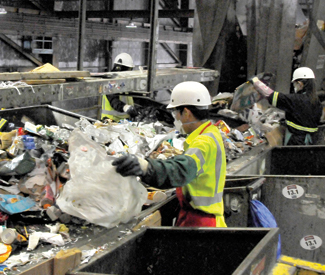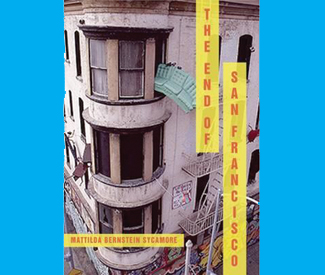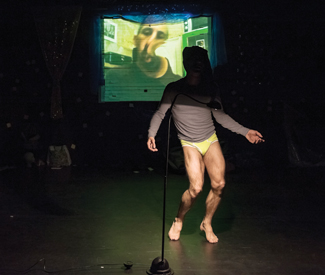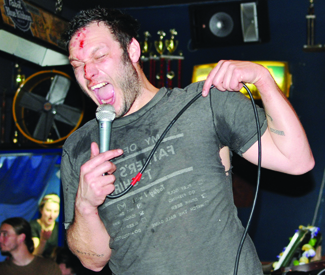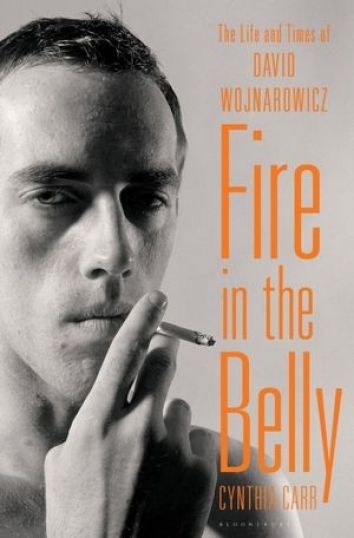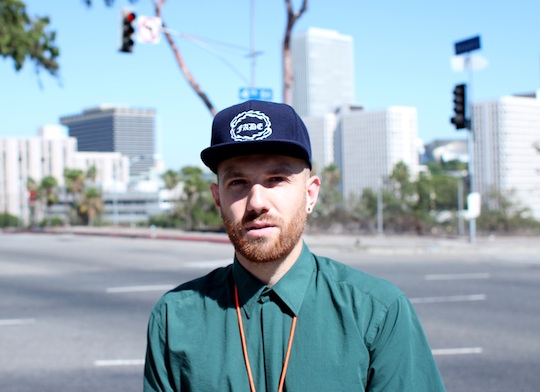Since club life is unpredictable, it’s a good idea to call ahead or check the venue’s website to confirm bookings and hours. Prices are listed when provided to us. Visit www.sfbg.com/venue-guide for venue information. Submit items for the listings at listings@sfbg.com. For further information on how to submit items for the listings, see Picks.
WEDNESDAY 26
ROCK/BLUES/HIP-HOP
Ryan Bingham, La Santa Cecilia Slim’s. 8pm, $26.
Claybourne, Kate Brown 50 Mason Social House. 7pm.
False, Blown to Bits, Lycus Elbo Room. 9pm, $7.
Felsen 50 Mason Social House. 9pm.
Ghost Parade, Stomacher, Soonest Bottom of the Hill. 9pm, $10.
Local H, Ambassadors Brick and Mortar Music Hall. 9pm, $12-$15.
Lonesome Heroes, Mariee Sioux, Jeffrey Manson Cafe Du Nord. 9pm, $10.
Menomena, PVY Bimbo’s. 8pm, $20.
Nathan and Rachel Johnny Foley’s. 9pm, free.
Obituary, Broken Hope, Decrepit Birth, Jungle Rot, Encrust, Feast DNA Lounge. 6:30pm, $18.
Owl City, Matthew Koma Regency Ballroom. 7:30pm, $25.
Amanda Palmer and the Grand Theft Orchestra Fillmore. 8pm, $25.
Papa Bear and the Easy Love, Kelly McFarling, DonCat Great American Music Hall. 8pm, $14-$16.
Steakhouse, Wounded Men, El Cajon Hemlock Tavern. 8:30pm, $6.
Soul Train Revival with Ziek McCarter Boom Boom Room. 8pm, $5.
Todd vs Guido Johnny Foley’s Dueling Pianos. 9:30pm.
JAZZ/NEW MUSIC
Cat’s Corner with Nathan Dias Savanna Jazz. 9pm, $10.
Cosmo AlleyCats Le Colonial, 20 Cosmo Place, SF; www.lecolonialsf.com. 7-10pm.
Dink Dink Dink, Gaucho, Eric Garland’s Jazz Session Amnesia. 7pm, free.
Ricardo Scales Top of the Mark, 999 California, SF; www.topofthemark.com. 6:30pm, $5.
“SF Underground Music Fest” 50 Mason Social House, SF; www.50masonsocialhouse.com. 8pm, $5. With Felsen, MK4, Real Numbers.
Paula West Yoshi’s SF. 8pm, $30.
FOLK/WORLD/COUNTRY
Bebel Gilberto Herbst Theater, 401 Van Ness, SF; www.cityboxoffice.com. 7pm.
DANCE CLUBS
Booty Call Q-Bar, 456 Castro, SF; www.bootycallwednesdays.com. 9pm. Juanita MORE! and Joshua J host this dance party.
Coo-Yah! Som., 2925 16th St, SF; (415) 558-8521. 10pm, free. DJs Daneekah and Green B spin reggae and dancehall with weekly guests.
Full-Step! Tunnel Top. 10pm, free. Hip-hop, reggae, soul, and funk with DJs Kung Fu Chris and Bizzi Wonda.
Hardcore Humpday Happy Hour RKRL, 52 Sixth St, SF; (415) 658-5506. 6pm, $3.
Obey the Kitty: Justin Milla Vessel, 85 Campton Place, SF; www.vesselsf.com. 1pm, $5.
THURSDAY 27
ROCK/BLUES/HIP-HOP
Marina Caviglia 50 Mason Social House. 7pm.
Dreamdate, Parlour Suite, She’s, Ian Fays, DJ Neil Martinson Brick and Mortar Music Hall. 10pm, $7-$10.
Grannies, Jetsinns, Psychology of Genocide Thee Parkside. 9pm, $7-$100. Blixafest/Bloomfest 2012.
Grass Widow, Rabbles, Apogee Sound Club, Future Twin Cell Space, 2050 Bryant, SF; www.sfcriticalmass.org. 7pm, $10-$20. SF Critical Mass 20th Birthday Party Bash.
Hey Champ, Frank and Derol, popscene DJs Rickshaw Stop. 9:30pm, $12-$14.
Hydrophonic: Scochella with Electric Shepherd, Rawdad, Vinyl Intermissions by Children of the Funk Slim’s. 8:30pm, $12.
John Lawton Trio Johnny Foley’s. 9pm, free.
Mark Sexton Band, Illusion of Self, Lemay Boom Boom Room. 8pm, $7.
Meiko Independent. 8pm, $15.
Moggs, Keiki, Goldring/Tompson Hemlock Tavern. 8:30pm, $7.
Panic is Perfect, Oceanography, DJ Blondie K Amnesia. 9pm, $7-$10.
Rare Animals, Ancient Mariner, Year of the Fist Bottom of the Hill. 9pm, $10.
“Stephan Jenkins Birthday Party and Concert: A Benefit for Classical Revolution” Great American Music Hall. 8pm, $20. With Classical Revolution Orchestra.
Rags Tuttle vs Todd Johnny Foley’s Dueling Pianos. 9:30pm.
JAZZ/NEW MUSIC
“Jazz Beyond Genre” Red Poppy Art House. 7pm, $12-$15. With Andrea Wolper, Hafez Modirzadeh, and more.
Stompy Jones Top of the Mark, 999 California, SF; www.topofthemark.com. 7:30pm, $10.
Ned Boyton Trio Bottle Cap, 1707 Powell, SF; www.bottlecapsf.com. 7-10pm.
Paula West Yoshi’s SF. 8pm, $30; 10pm, $20.
FOLK/WORLD/COUNTRY
Twang! Honky Tonk Fiddler’s Green, 1330 Columbus, SF; www.twanghonkytonk.com. 5pm. Live country music, dancing, and giveaways.
DANCE CLUBS
Afrolicious Elbo Room. 9:30pm, $5-$7. With DJ-host Pleasuremaker spinning Afrobeat, Tropicália, electro, samba, and funk
All 80s Thursday Cat Club. 9pm, $6 (free before 9:30pm). The best of 80s mainstream and underground.
Base: Roman Flugel, Galen Vessel, 85 Campton Place, SF; www.vesselsf.com. 10pm, $5-$10.
Dixon, Solar Public Works. 9pm, $15.
Tropicana Madrone Art Bar. 9pm, free. Salsa, cumbia, reggaeton, and more.
FRIDAY 28
ROCK/BLUES/HIP-HOP
Afromassive Boom Boom Room. 8pm, $15.
Father John Misty, Jenny O. Independent. 9pm, $15.
Colleen Green, Plateaus, Courtney and the Crushers, Memories, Pamela Thee Parkside. 9pm, $8.
Hatebreed, Whitechapel, All Shall Perish, Deeznuts Regency Ballroom. 7:30pm, $23.
Institution, Ray Frankly, Cheating Daylight, Wesley Project Slim’s. 7pm, $15.
Kasey Johansing, Bart Davenport, Anna Ash Brick and Mortar Music Hall. 9pm, $9-$12.
Jonah’s onelinedrawing, Iamani, Ben Flanagan, Safiya Martinez, MacClain and Cole Bottom of the Hill. 8:30pm, $10.
Kim Lenz and Her Jaguars, B-Stars, Rocketship Rocketship Verdi Club, 2424 Mariposa Ave., SF; www.verdiclub.net. 8pm, $10.
Pine Box Boys, King City, Trainwreck Riders Elbo Room. 9pm, $10.
Starbaby 50 Mason Social House. 10pm.
This Charming Band, For the Masses Cafe Du Nord. 9pm, $12.
Todd, Rome Balestrieri, Jason Marion Johnny Foley’s Dueling Pianos. 9pm.
Top Secret Band Johnny Foley’s. 9pm, free.
Vir, Here Come the Saviours, Erik Blood Hemlock Tavern. 9:30pm, $7.
Zodiac Death Valley, Finsh Ticket, Dandelion War, Chaw Rickshaw Stop. 8pm, $12.
JAZZ/NEW MUSIC
Audium 1616 Bush, SF; www.audium.org. 8:30pm, $20. Theater of sound-sculptured space.
Black Jazz Orchestra Top of the Mark, 999 California, SF; www.topofthemark.com. 9pm, $10.
“Bunker A/V Sessions Pt. 3” Monarch, 101 Sixth, SF; gafftabunker3.eventbrite.com. 9pm, $10-$20. With Peter Van Hoesen, Derek Plaslaiko.
Terry Disely Bottle Cap, 1707 Powell, SF; www.bottlecapsf.com. 5:30-8:30pm.
Peter White Yoshi’s SF. 8pm, $26; 10pm, $22.
FOLK/WORLD/COUNTRY
Baxtolo Drom Amnesia. 9pm, $7-$10. Live music, gypsy punk, belly dance.
Kato-vento Brazilian Ensemble Community Music Center, 544 Capp, SF; www.kato-vento.com. 8pm, $10-$15.
Taste Fridays 650 Indiana, SF; www.tastefridays.com. 8pm, $18. Salsa and bachata dance lessons, live music.
DANCE CLUBS
Direct to Earth 222 Hyde, SF; www.residentadvisor.net. 10pm, $20. Creator Series event with Truncate.
Joe Lookout, 3600 16th St.,SF; www.lookoutsf.com. 9pm. Eight rotating DJs, shirt-off drink specials.
Deniz Koyu, Ron Reeser Vessel, 85 Campton Place, SF; www.vesselsf.com. 10pm, $10-$30.
Old School JAMZ El Rio. 9pm. Fruit Stand DJs spinning old school funk, hip-hop, and R&B.
Paris to Dakar Little Baobab, 3388 19th St, SF; (415) 643-3558. 10pm, $5. Afro and world music with rotating DJs.
Project Mayhem DNA Lounge. 9pm, $10-$15. With Flinch, Bassex, Liam Shy, Atom One, Harris Pilton.
Public Access 2: Andy Stott, Demdike Stare, Balam Acab, oOoOO Public Works. 10pm, $10-$12.
SATURDAY 29
ROCK/BLUES/HIP-HOP
Back Pages Johnny Foley’s. 9pm, free.
Beat Junkies Mighty. 10pm, $20.
Daniel Bedingfield, DJ Haute Toddy Cafe Du Nord. 9pm, $15.
Erin Brazil and the Brazillionaires, Hang Jones Amnesia. 9pm, $7-$10.
Carlton Melton, Phil Manley Life Coach, White Manna El Rio. 10pm, $8.
Firewater, Damon and the Heathens Independent. 8pm, $15.
Scott Kelley and the Road Home, Mike Scheidt Hemlock Tavern. 9:30pm, $12.
Aimee Mann Fillmore. 9pm, $35.
Melvins Seals Birthday Celebration Great American Music Hall. 9pm, $30. JGB with Melvin Seals, Dave Ellis.
“Polk Street Blues Festival” Polk Street from Jackson to California, SF; www.polkstreetbluesfestival.com. 11am-6pm. With Buckaroo Bonet, Bobbie Webb and Smooth Blues Band, Andre Theirry, SF Rock Project, and more.
“Ripstar Musicfest” Sub-Mission. 8pm, $7-$10. With Oddville, Straight Ups, Chunky Turtlenecks, Elegant Trash, and benefiting the Red Cross.
Rock on Broadway 50 Mason Social House. 8pm.
Rodriguez Bimbo’s. 9pm, $20.
Rustangs Riptide. 9:30pm, free.
SafetySuit, Go Radio, James Leste Bottom of the Hill. 9pm, $15.
Scooter and Lavelle, Ross FM Vessel, 85 Campton Place, SF; www.vesselsf.com. 10pm, $10-$30.
Spotted Botanists Sub-Mission. 4pm, $5.
Todd, Jason Marion, Rome Balestrieri Johnny Foley’s Dueling Pianos. 9pm.
Trainwreck Riders, Saything, Slow Trucks, Ugly Winner, Speak Friend, Quiet Americans Thee Parkside. 2pm, $10.
“UnderCover Presents: Joni Mitchell’s Blue” Brava Theater, 2781 Mission, SF; www.undercoverpresents.com. 7:30pm, $12-$35. With KillBossa, Kelly McFarling, Amy X Neuberg, Seshen, and more.
Welcome Matt Exit Theater, 56 Eddy, SF; Facebook: Song Writer Saturdays. 9:30pm, free.
William Elliot Whitmore, Samantha Crain Slim’s. 9pm, $16.
Yo Mama’s Big Fat Booty Boom Boom Room. 8pm, $15.
Youngblood Hawke, Young Digerati, Young Science, DJ Aaron Axelson Brick and Mortar Music Hall. 9pm, $10.53.
JAZZ/NEW MUSIC
Audium 1616 Bush, SF; www.audium.org. 8:30pm, $20. Theater of sound-sculptured space.
Peter White Yoshi’s SF. 8pm, $30; 10pm, $22.
FOLK/WORLD/COUNTRY
Shook Twins, Country Mourns, Dirt Floor Band SF Live Arts Music Series at Cyperian’s, 2097 Turk, SF; www.noevallleymusicseries.com. 7:30pm, $12.
Craig Ventresco and Meredith Axelrod Atlas Cafe, 3049 20th St, SF; www.atlascafe.net. 4-6pm.
DANCE CLUBS
“A Night of Local House Music from Mother Records” Raven Bar and Lounge, 1151 Folsom, SF; www.ravenbarsf.com. 10pm, free.
Bootie SF: Bootie Hoedown DNA Lounge. 9pm, $10-$15. Bootie DJs spin country-western roadhouse mashups.
Paris to Dakar Little Baobab, 3388 19th St, SF; (415) 643-3558. 10pm, $5. Afro and world music with rotating DJs including Stepwise, Steve, Claude, Santero, and Elembe.
Sweater Funk Elbo Room. 9pm, $10. Four-year anniversary with all members including Mamabear and Shred One.
SUNDAY 30
ROCK/BLUES/HIP-HOP
Album Leaf, Blackbird Blackbird, Drew Andrews Bottom of the Hill. 9pm, $15.
Coyote Grace, Mamuse Great American Music Hall. 8pm, $12-$15.
Rick Estrin and the Nightcats Biscuits and Blues. 7 and 9pm, $20.
Hot Water Music, Dead to Me, Heartsands Slim’s. 8pm, $21.
Inner Ear Brigade, Marco Eneidi’s Shattered, Mutual Aid Project Hemlock Tavern. 8:30pm, $7.
John Lawton Trio Johnny Foley’s. 9pm, free.
Canyon Johnson 50 Mason Social House. 8pm.
Jason Marion vs Nathan Temby Johnny Foley’s Dueling Pianos. 9pm.
Maria Minerva, Father Finger, Bobby Browser, Epicsauce DJs Rickshaw Stop. 8pm, $10-$12.
Mission Bells, Bear Crossing, Torches Cafe Du Nord. 8:30pm, $8.
“Polk Street Blues Festival” Polk Street from Jackson to California, SF; www.polkstreetbluesfestival.com. 11am-6pm. With Ed Earley Band and Jay Bonet, BABS Caravan of All-Stars, James Moseley Band, Juce Garcia Band, and more.
Tomten, Flying Childers Brick and Mortar Music Hall. 9pm, $5-$8.
“UnderCover Presents: Joni Mitchell’s Blue” Brava Theater, 2781 Mission, SF; www.undercoverpresents.com. 6pm, $12-$35.With Beth Custer Ensemble, Kitka, Adam Theis of Jazz Mafia, Bhrathi Palivela and Daniel Fabricant, and more.
“Under the Central Freeway” Public Works. 2-9pm, $15. With Kelley Stoltz, Religious Girls, Sweet Chariot, Will Sprott.
Vows, Blank Tapes, Ash Reiter, Li Xi, Cannons and Clouds, Fpod Bpod, Upstairs Downstairs Thee Parkside. 2pm, $10.
JAZZ/NEW MUSIC
Slippery Slope, Daisy Spot Yoshi’s SF. 7pm, $14.
Snarky Puppy Boom Boom Room. 8pm, $12.
FOLK/WORLD/COUNTRY
Twang Sunday Thee Parkside. 4pm, free. With Jinx Jones and the King Tones.
DANCE CLUBS
Dub Mission Elbo Room. 9pm, $6. Dub, roots, and classic dancehall with DJ Sep, Vinnie Esparza, Lud Dub.
Jock Lookout, 3600 16th St, SF; www.lookoutsf.com. 3pm, $2.
Sunday Soiree Phoenix Hotel, 601 Eddy, SF; sundayphoenix.eventbrite.com. 1-8pm. With DJ Shorkut, Jeremy Sole, Vinroc and King Most.
MONDAY 1
ROCK/BLUES/HIP-HOP
Blood Red Shoes, Happy Fangs, Starskate Rickshaw Stop. 8pm, $10-$12.
Damir Johnny Foley’s. 9pm, free.
Former Babies, Koko Beware Hemlock Tavern. 6pm, $5.
Garbage, Screaming Females Warfield. 8pm, $38-$48.
Grouplove, Alt-J Fillmore. 8pm, $25.
Ariel Pink’s Haunted Graffiti, Dam Funk, Bodyguard Bimbo’s. 8pm, $20.
JC Rockit vs Guido Johnny Foley’s Dueling Pianos. 9:30pm.
JAZZ/NEW MUSIC
Bossa Nova Tunnel Top, 601 Bush, SF; (415) 722-6620. 8-11:30pm, free. Live acoustic Bossa Nova.
DANCE CLUBS
Crazy Mondays Beauty Bar, 2299 Mission, SF; www.thebeautybar.com. 10pm, free. Hip-hop and other stuff.
Death Guild DNA Lounge. 9:30pm, $3-$5. Goth-industrial dance night with Decay, Joe Radio, Melting Girl.
M.O.M. Madrone Art Bar. 6pm, free. DJs Timoteo Gigante, Gordo Cabeza, and Chris Phlek playing all Motown every Monday.
Soul Cafe John Colins Lounge, 138 Minna, SF; www.johncolins.com. 9pm. R&B, Hip-Hop, NeoSoul, Reggae, Dancehall, Reggaeton, Salsa and more with DJ Jerry Ross. Happy hour all night.
Vibes’N’Stuff El Amigo Bar, 3355 Mission, SF; (415) 852-0092. 10pm, free. Conscious jazz and hip-hop from 1960s-early ’90s with DJs Luce Lucy, Vinnie Esparza, and more.
TUESDAY 2
ROCK/BLUES/HIP-HOP
Communist Daughter, Sporting Life Elbo Room. 9pm, $7.
Colin Ludlow and the Folks, General 50 Mason Social House. 8pm.
Ron Pope, Jerad Finck, Anjus Pale Blue Eyes Cafe Du Nord. 7:30pm, $15.
Port-Royal, Dryft, Another Electronic Musician DNA Lounge. 8pm, $12.
Psychedelic Furs, Chevin Bimbo’s. 8pm, $30.
Sidekicks, John Moremen’s Flotation Device Bottom of the Hill. 9pm, $8.
Space Vacation, Ironwitch Hemlock Tavern. 8:30pm, $7.
Stan Erhart Band Johnny Foley’s. 9pm, free.
Rags Tuttle vs Randy Johnny Foley’s Dueling Pianos. 9:30pm.
Patrick Wolf Great American Music Hall. 8pm, $21.
JAZZ/NEW MUSIC
Clarice Assad Yoshi’s SF. 8pm, $22.
Gaucho Bottle Cap, 1707 Powell, SF; www.bottlecapsf.com. 7-10pm.
FOLK/WORLD/COUNTRY
Belle Monroe and Her Brewglass Boys Amnesia. 9pm.
DANCE CLUBS
Eclectic Company Skylark, 9pm, free. DJs Tones and Jaybee spin old school hip hop, bass, dub, glitch, and electro.


